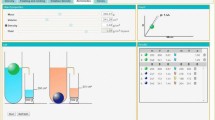Abstract
RIALE (Remote Intelligent Access to Lab Experiment) is a concept designed to supplement school science laboratories. Its multifunctional platform for innovative learning applications offers a multimodal approach of science. During Lab experiments Internet of Things (IoT) devices collect data, while an Artificial Intelligence (AI) tool is trained to recognize the tools, identify procedures and protocol phases, highlight the results of quantitative observations and tag collected data in a Timeline enriched with tagged additional educational contents (videos, external links, etc.). After remotely witnessing live the Lab experiment, students will access all educational contents from the platform to go deeper into single aspects of the experiment. A second AI tool will explore students’ approaches to learning, enabling us, in the long term, to obtain a user-friendly tool that will give information on students’ learning styles and help adapt teaching to their learning needs and styles. The first RIALE experiment deals with bioinformatics analysis. The educational scenario deals with exome sequencing and related scientific concepts (family tree, inheritance, genes…).
Access this chapter
Tax calculation will be finalised at checkout
Purchases are for personal use only
Similar content being viewed by others
References
Salis, C., Zedda, D., et al.: Teacher coaching program – the IDEA linea B3 project. In: 2nd International Conference on Advanced Research in Education, Diamond Scientific Pub., Paris (2019)
Heradio, R., de la Torre, L., Galan, D., Cabrerizo, F.J., et al.: Virtual and remote labs in education: a bibliometric analysis. Comput. Educ. 98(Issue C), 14–38 (2016)
Chen, G., Fu, X.: Effects of multimodal information on learning performance and judgment of learning. J. Educ. Comput. Res. 29(3), 349–362 (2003)
Kalali, F.: L’enseignement des Sciences expérimentales, ou le débat récurrent du culturel versus utilitaire: quels problèmes? SPIRALE - Revue des Recherches en Education 42, 183–194 (2008)
Gruson, C.: L’expérimentation scientifique permet-elle le développement de l’esprit critique de l’élève? Education, Hal Id. dumas-00750748 (2012)
Bossewitch, J., Preston, M.D.: Teaching and learning with video annotations. In: Learning Through Digital Media Experiments in Technology and Pedagogy, vol. 19, pp. 175–184. The Institute for Distributed Creativity, R.T. Scholz Editor, New York, NY, USA (2011)
Van Der Maren, J.M., Salis, C., Gardina, M., Froissart, B.: Profil d’utilisation d’adjuvants didactiques en mode hypertexte par des étudiants universitaires, in: Apprendre à l’université “tête bien faite….tête bien pleine”. In: actes du congrès de l’Association Internationale de Pédagogie Universitaire, pp. 205–214. AIPU, Sainte-Foy, Laval, Canada (1992)
Szegedy, C., et al.: Going deeper with convolutions. In: 28th IEEE Conference on Computer Vision and Pattern Recognition (CVPR), Boston, MA, USA, pp. 1–9 (2015)
Sandler, M., Howard, A., Zhu, M., Zhmoginov A., Chen, L.: MobileNetV2: inverted residuals and linear bottlenecks. In: IEEE/CVF Conference on Computer Vision and Pattern Recognition, 2018, Salt Lake City, UT, USA, pp. 4510–4520 (2018)
Miech, A., Laptev, I., Sivic, J.: Learnable pooling with Context Gating for video classification (2018). ar**v:1706.06905v2. Accessed 31 Mar 2020
Lin, R., **ao, J., Fan, J.: NeXtVLAD: An Efficient Neural Network to Aggregate Frame-level Features for Large-scale Video Classification (2018). ar**v:1811.05014v1. Accessed 31 Mar 2020
Ma, J., Gorti, S.K., Volkovs, M., et al.: Cross-Class Relevance Learning for Temporal Concept Localization (2019). ar**v:1911.08548v1. Accessed 31 Mar 2020
Fernández-Marmiesse, A., Gouveia, S., et al.: NGS technologies as a turning point in rare disease research, diagnosis and treatment. Curr. Med. Chem. 25, 404–432 (2018)
Vrijenhoek, T., Kraaijeveld, K., Elferink, M., et al.: Next-generation sequencing based genome diagnostics across clinical genetics centers: implementation choices and their effects. Eur. J. Hum. Genet. 1142–1150. Nature Publishing Group (2015)
Coonrod, E.M., Durtschi, J.D., Margraf, R.L., et al.: Develo** genome and exome sequencing for candidate gene identification in inherited disorders: an integrated technical and bioinformatics approach. Arch. Pathol. Lab. Med. 137, 415–433 (2013)
Voelkerding, K.V., Dames, S.A., Durtschi. J.D.: Next-generation sequencing: from basic research to diagnostics. Clin. Chem. 55, 641–658 (2009)
Hardy, J., Singleton, A.: Genome wide association studies and human disease. N. Engl. J. Med. 360, 1759–1768 (2009)
Cooper, D.N., Krawczak, M., Antonorakis, S.E.: The nature and mechanisms of human gene mutation. In: The Metabolic and Molecular Bases of Inherited Disease, 7th edn., pp. 259–291. McGraw-Hill Education, USA, (2019)
Bruinsma, S., Burgess, J., Schlingman, D.: Bead-linked transposomes enable a normalization-free workflow for NGS library preparation. BMC Genom. 19, 722 (2018)
Acknowledgements
The authors gratefully acknowledge the “Servizio Istruzione of Direzione Generale della Pubblica Istruzione of Assessorato della Pubblica Istruzione, Beni Culturali, Informazione, Spettacolo e Sport of RAS” and “Sardegna Ricerche”.
Author information
Authors and Affiliations
Corresponding author
Editor information
Editors and Affiliations
Rights and permissions
Copyright information
© 2021 The Author(s), under exclusive license to Springer Nature Switzerland AG
About this paper
Cite this paper
Salis, C. et al. (2021). Multimodal Access to Scientific Experiments Through the RIALE Platform - Main Steps of Bioinformatics Analysis. In: Auer, M.E., Centea, D. (eds) Visions and Concepts for Education 4.0. ICBL 2020. Advances in Intelligent Systems and Computing, vol 1314. Springer, Cham. https://doi.org/10.1007/978-3-030-67209-6_9
Download citation
DOI: https://doi.org/10.1007/978-3-030-67209-6_9
Published:
Publisher Name: Springer, Cham
Print ISBN: 978-3-030-67208-9
Online ISBN: 978-3-030-67209-6
eBook Packages: Intelligent Technologies and RoboticsIntelligent Technologies and Robotics (R0)




